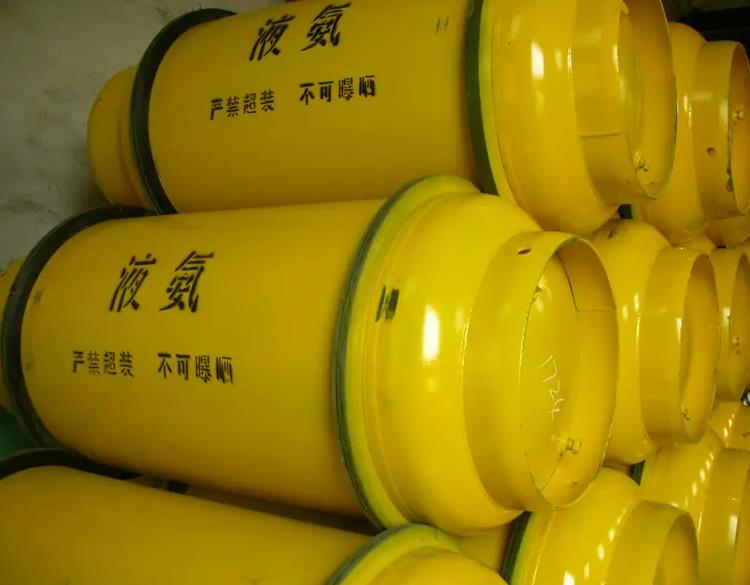Flüssiges Ammoniak wird hauptsächlich zur Herstellung von Salpetersäure, Harnstoff und anderen chemischen Düngemitteln verwendet und kann auch als Rohstoff für Arzneimittel und Pestizide eingesetzt werden.
1. In der nationalen Verteidigungsindustrie wird es zur Herstellung von Treibstoffen für Raketen und Flugkörper verwendet.
2. Wird als Ammonium-Rohstoff für organische chemische Produkte und auch als Kühlmittel verwendet.
Die freien Elektronenpaare in NH3-Molekülen neigen dazu, Koordinationsbindungen mit anderen Molekülen oder Ionen zu bilden, wodurch verschiedene Formen von Ammoniakkomplexen entstehen. Komplexe wie [Ag (NH3) 2]+, [Cu (NH3) 4] 2+, BF3 • NH3 usw. sind alle mit NH3 koordiniert.
3. Flüssiges Ammoniak wird auf 800–850 °C erhitzt und unter Einwirkung von Nickelkatalysatoren zersetzt, um ein Wasserstoff-Stickstoff-Gemisch mit 75 % H2 und 25 % N2 zu erhalten. Das so gewonnene Gas ist ein gutes Schutzgas.
4. Es kann in großem Umfang in der Halbleiterindustrie, der metallurgischen Industrie sowie in anderen Industrien und in der wissenschaftlichen Forschung eingesetzt werden, die eine Schutzatmosphäre erfordern.
5. Wird in verschiedenen chemischen Hilfsstoffen, beim Schmelzen und in anderen Industrien verwendet.

Hinweise:
Ammoniak wirkt ätzend und reizend auf das Hautgewebe, kann diesem Wasser entziehen, Gewebeproteine denaturieren, Gewebefett verseifen und die Zellmembranstruktur zerstören. Aufgrund seiner extrem hohen Löslichkeit wirkt Ammoniak vor allem auf die oberen Atemwege von Tieren und Menschen reizend und ätzend. Es lagert sich häufig auf Haut, Schleimhäuten und Bindehaut ab und verursacht Reizungen und Entzündungen. Es kann die Atemflimmerhärchen lähmen und das Schleimhautepithel schädigen, wodurch pathogene Mikroorganismen leichter eindringen und die Widerstandskraft des Körpers gegen Krankheiten geschwächt wird. Ammoniak wird üblicherweise gasförmig eingeatmet. Nach dem Einatmen gelangt Ammoniak leicht über die Lungenbläschen ins Blut, bindet sich an Hämoglobin und stört den Sauerstofftransport. Eine geringe Menge Ammoniak, die in die Lungenbläschen gelangt, wird durch Kohlendioxid neutralisiert, der Rest wird ins Blut aufgenommen. Geringe Mengen Ammoniak können über Schweiß, Urin oder Atmung ausgeschieden werden. Kurzfristig kann das Einatmen großer Mengen Ammoniak Tränenfluss, Halsschmerzen, Heiserkeit, Husten, blutigen Auswurf, Engegefühl in der Brust und Atembeschwerden verursachen. Schwindel, Kopfschmerzen, Übelkeit, Erbrechen, Müdigkeit usw. können die Folge sein. In schweren Fällen können Lungenödem, akutes Atemnotsyndrom (ADS) und Atemwegsreizungen auftreten. Das Einatmen von zu viel Ammoniak und die damit verbundene hohe Ammoniakkonzentration im Blut können durch Reflexe der Trigeminusnervenenden zu Herz- und Atemstillstand führen und so lebensgefährlich sein. Langfristige Ammoniakbelastung kann bei manchen Menschen Symptome wie Hautverfärbungen oder Fingergeschwüre hervorrufen. Ammoniak in der Raumluft stammt hauptsächlich aus Betonzusatzstoffen, die im Bauwesen verwendet werden. Diese Betonzusätze enthalten große Mengen an Ammoniak, das durch Veränderungen von Umweltfaktoren wie Temperatur und Luftfeuchtigkeit zu Ammoniakgas reduziert und in der Wand freigesetzt wird.
Notfallmaßnahmen:
Die physiologischen Auswirkungen von Ammoniak auf den menschlichen Körper. Ammoniak hat einen starken, reizenden Geruch und ist hochgiftig für den menschlichen Körper. Eine chronische Ammoniakvergiftung kann Atemwegserkrankungen wie chronische Bronchitis und Emphysem verursachen, während sich eine akute Ammoniakvergiftung in anhaltendem Husten und Erstickungsanfällen äußert.
(1) Kleine Leckage.
Evakuieren Sie alle Personen im Bereich. Vermeiden Sie das Einatmen von Dämpfen und den Kontakt mit Flüssigkeiten oder Gasen. Beim Umgang mit dem Material sollten Atemschutzgeräte getragen werden. Vermeiden Sie das Betreten von engen Räumen, in denen sich Ammoniak ansammeln kann, und verstärken Sie die Belüftung. Leckagen können nur unter Wahrung der Sicherheit verschlossen werden. Der undichte Behälter sollte in einen sicheren Bereich gebracht und das Ventil zur Druckentlastung erst geöffnet werden, wenn die Sicherheit gewährleistet ist. Inerte Absorptionsmaterialien wie Sand und Vermiculit können zum Auffangen und Absorbieren ausgetretener Materialien verwendet werden. Die aufgefangene Leckage sollte zur Entsorgung in einen verschlossenen Behälter mit entsprechender Kennzeichnung gegeben werden.
(2) Große Leckagemenge.
Evakuieren Sie alle ungeschützten Personen am Veranstaltungsort und bringen Sie sie gegen den Wind. Das Personal zur Beseitigung der Leckage muss vollständig geschlossene, schwere Chemikalienschutzkleidung und Atemschutzgeräte tragen und den Leckagebereich nach Ergreifen persönlicher Schutzmaßnahmen mit Wassersprühstrahl säubern. Durch die Verdünnung mit einer Wasserpistole verflüchtigt sich das Ammoniakgas vor Ort allmählich. Die Leckagestelle wird mit einem funkenfreien Werkzeug abgedichtet.
Melden Sie den Vorfall der örtlichen Regierung unter der Rufnummer „119“, den örtlichen Umweltschutzbehörden, den Behörden für öffentliche Sicherheit und der Verkehrspolizei. Der Bericht sollte die Unfallstelle, die Zeit, den Ort, die Bezeichnung der Chemikalie, die Menge des ausgetretenen Materials und den Grad der Gefahr des Unfalls, das Vorhandensein von Opfern sowie den Namen und die Telefonnummer der Person, die den Vorfall gemeldet hat, enthalten.
Vermeiden Sie den Kontakt mit ausgetretenem flüssigem Ammoniak und vermeiden Sie dessen Überquerung, um ein Eindringen in die Kanalisation und Entwässerungskanäle zu verhindern. Verbessern Sie die Belüftung. Rauchen und offenes Feuer sind auf dem Gelände verboten. Unter Wahrung der Sicherheit ist es notwendig, den undichten Behälter zu verschließen oder umzudrehen, um ein Austreten von flüssigem Ammoniak zu verhindern. Sprühen Sie Wasser, um den Dampf zurückzuhalten oder die Strömungsrichtung der Dampfwolke zu ändern. Es ist jedoch verboten, das ausgetretene flüssige Ammoniak oder die Leckagequelle direkt mit Wasser zu beeinflussen. Verhindern Sie, dass das Leck in Gewässer, die Kanalisation, Keller oder geschlossene Räume gelangt. Vermeiden Sie das Betreten geschlossener Räume, in denen sich Ammoniak ansammeln kann. Nach der Reinigung sollten alle Schutzkleidungen und -ausrüstungen vor der Lagerung und Wiederverwendung abgewaschen werden.




